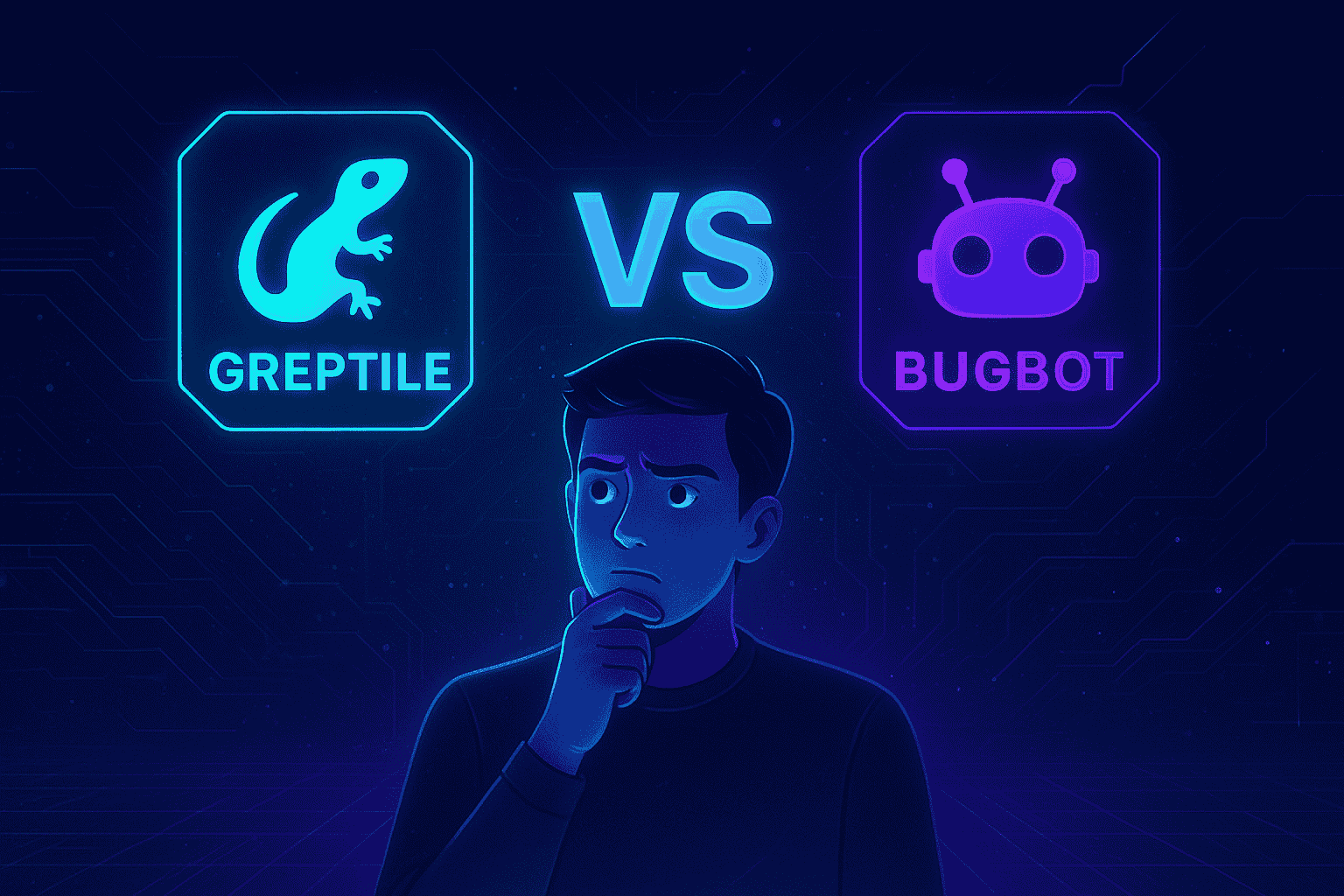Introduction
In the world of software engineering, code reviews are a critical checkpoint. They protect against regressions, catch security issues, and improve maintainability. But manual reviews can become bottlenecks—delays, inconsistent feedback, and reviewer fatigue all threaten code quality.
AI-driven development aim to change that. They integrate into pull request workflows, automatically analyse diffs (and sometimes full codebases), flag issues, and suggest fixes. In this article, we compare two notable tools: Greptile and Bugbot. Our goal: deliver a clear, data-grounded comparison to help engineering leaders decide which fits their team best.
- Greptile positions itself as a deep, context-aware reviewer built for teams that care about quality across complex systems.
- Bugbot takes a somewhat leaner approach—targeting logic bugs, edge cases, and rapid feedback, especially in fast-moving codebases.
Let’s dive into how we evaluated them, the numbers behind each, and what real teams should consider.
How We Evaluated the Tools
To provide meaningful comparison, we used the following dimensions (inspired by a standard set of review criteria):
- Critical Bugs: Bugs that break functionality, introduce security issues, or cause major failures.
- High/Medium Bugs: Logic mistakes, missing validations, edge-case errors.
- Refactoring / Maintainability Suggestions: Feedback on duplication, architecture, naming, code structure.
- Performance / Optimization Suggestions: Improvement opportunities in speed, memory, throughput.
- Nitpicks / Style: Minor issues — formatting, naming conventions, low-severity.
- False Positives / Noise: Feedback that flags non-issues or low-value comments.
Additional metrics:
- Bug-catch rate: percent of known issues flagged.
- Signal-to-noise: ratio of valuable comments to extraneous ones.
- Turnaround/latency: how quickly feedback appears on a PR.
- Workflow/integration cost: how much setup and overhead is required.
- Pricing/licensing context.
Where available, we presented vendor-reported benchmarks and independent commentary (with appropriate caveats). Because not all metrics are publicly verified, treat the values as directional, not absolute.
Key Metrics for Each Tool
Greptile
Reported numbers and vendor claims:
- A public benchmark claims an overall bug-catch rate of ~82% on a set of 50 real-world bugs.
- For “Critical” severity bugs in that benchmark: 58%. For “High” severity bugs: 100%.
- Greptile also claims that teams using it achieve up to 4× faster PR merges and catch ~3× more bugs.
- Pricing: public listing at approximately US $30 per developer per month.
- Language support: widely listed (Python, JavaScript/TypeScript, Go, Java, C/C++, Rust, PHP, etc).
- Workflow: emphasises “full code-base context” (not just the diff) and integrates with GitHub/GitLab.
Important caveats:
- The numbers are vendor-provided and may reflect optimal settings.
- False positive / signal-to-noise data is less detailed.
- Deeper review means more commentary; that might increase reviewer load if not managed.
Bugbot
Reported numbers and vendor commentary:
- One early data point: more than 1 million pull requests reviewed, ~1.5 million potential issues flagged, with ~50% of flagged issues fixed before merging.
- Claims of ~40% of code-review time saved for teams using it.
- Pricing anecdote: around US $40/month per user for 200 PRs in one reporting.
- Workflow: built by a team known for developer-experience tooling; emphasis on minimal setup, quick integration (especially for GitHub) and catching logic/security bugs, including in AI-generated code.
Important caveats:
- Publicly disclosed bug-catch rates (percentage) are not detailed.
- Independent reviews suggest some workflow friction and UX complaints in certain setups.
- The focus is narrower (bug detection) vs a broader code-health posture.
Side-by-Side Comparison: Greptile vs Bugbot
Metrics Summary Table
| Metric | Greptile | Bugbot |
|---|---|---|
| Claimed bug-catch rate | ~82% (on a 50-bug benchmark) | ~50% of flagged issues fixed (from early dataset) |
| Critical-bug detection (vendor benchmark) | 58% | Not publicly broken out |
| PR merge speed improvement claim | Up to 4× faster merges | ~40% less review time |
| Signal-to-noise / false positive risk | Commentary suggests higher noise due to richer feedback | Fewer, more focused comments claimed but less public data |
| Refactoring & performance suggestions | Broad: includes maintainability, architecture, performance | Narrower: emphasises logic/security bugs rather than full refactor/optimize |
| Integration & ease-of-use | Strong integration, full context, may need tuning | Lean setup, quick to adopt, minimal config |
| Cost (public data) | ~US $30/dev/month | ~US $40/dev/month (for 200 PRs in anecdote) |
| Best-fit scenario | Teams caring deeply about quality, multi-language, complex codebases | Fast-moving teams, AI-generated code, minimal overhead workflows |
Narrative Comparison
Code smell detection and coverage: Greptile leads in published detection metrics: the ~82% rate and 58% “Critical” detection claim are strong. Bugbot’s data is less granular but the scale of early usage (1 M+ PRs) is impressive. If you prioritise catching as many hidden defects as possible, Greptile may have the edge. If you care mainly about logic bugs in rapidly iterating code, Bugbot is compelling.
Workflow speed and friction: Bugbot touts a ~40% reduction in review time and emphasises quick setup; Greptile claims up to 4× faster merges but may require more onboarding and tuning. For teams wanting minimal disruption, Bugbot is leaner; for teams prepared to invest in deeper review flows, Greptile may pay off.
Code Quality vs Code Noise: With deeper feedback comes the risk of overwhelming reviewers. Greptile’s rich suggestions for refactoring and performance may introduce more comments (some lower-priority). Bugbot’s narrower focus may reduce review fatigue but at the cost of breadth. Teams should plan for how much commentary they can absorb.
Maintainability and future-proofing: If you care about architectural issues, reducing technical debt, performance optimisations and long-term code health, Greptile’s broader scope is advantageous. If your immediate concern is catching bugs and shipping fast, Bugbot suffices.
Pricing and Scale: The nominal pricing difference is modest, but actual cost impact depends on teams, number of PRs, languages used, and how many false positives you end up reviewing. Also factor in the cost of reviewer time and tool setup.
Strengths & Weaknesses
Greptile
Strengths
- Strong public-facing metrics for bug detection.
- Broad coverage (bugs + refactoring + performance + architecture).
- Full codebase context engineering adds depth to reviews.
- Good language/platform support.
Weaknesses
- More setup and tuning may be required.
- Potential for comment overload if not managed.
- Vendor-published data; independent real-world studies fewer.
- For teams prioritising speed above all, may feel heavy.
Bugbot
Strengths
- Lean, fast, minimal friction integration.
- Good for rapid development workflows and logic/security bug detection.
- Developer-friendly, especially in fast-moving environments.
- Early large scale usage suggests utility at volume.
Weaknesses
- Less published transparency on deep metrics (false positives, architecture suggestions).
- Narrower focus: less emphasis on refactoring/optimisation.
- Some reports of UX/workflow rough edges.
- Might not address broader code quality issues for teams with significant legacy or multi-language repos.
Which Tool Should You Choose?
Here are key questions to guide your decision:
- What’s your top priority?
- If you care mostly about catching logic/security bugs in fast-moving code, Bugbot is very strong.
- If you care about deep maintainability, architecture, performance and want to reduce tech-debt proactively, Greptile wins.
- How much review bandwidth do you have?
- If reviewers are already overloaded and you want minimal additional commentary, Bugbot’s leaner style may be better.
- If your team can absorb richer feedback cycles and is ready to act on suggestions and customization, Greptile offers more value.
- How mature is your codebase?
- For newer or greenfield projects, a simpler tool may serve well.
- For mature, multi-language, multi-repo codebases with legacy issues, deeper tooling like Greptile is a smart investment.
- What languages/platforms are you using?
- Ensure whichever tool supports your stack well. Greptile lists many languages; Bugbot tends to emphasise GitHub/VSCode workflows but check your specifics.
- What’s the ROI and cost structure?
- Estimate how many PRs you process, how many bugs you expect to catch, how much reviewer time you’ll save.
- Consider the true cost of false positives and review overhead.
- What signal-to-noise ratio will your team tolerate?
- If your team dislikes being flooded by comments, go with a tool that emphasises quality over quantity.
- If your team will act on many suggestions and sees feedback as valuable, a richer tool is justified.
Suggested scenario fit
- Fast-moving startup with frequent deployments: Choose Cursor Bugbot, get quick wins, ship faster, catch basic logic/security issues.
- Large org with complex codebase, legacy debt, multiple languages: Choose Greptile, invest in deeper quality and tech-debt reduction, build mature review habits.
- Mixed scenario: You might even pilot both. Use Bugbot for rapid development branches and Greptile for major release branches or refactor sweeps. Just be mindful of tool fatigue and overlap.
Final Thoughts
Both Greptile and Bugbot represent the next evolution in code-review tooling. They shift manual review from being purely human-driven to a hybrid model where AI coding tools augment developer effort—catching issues sooner, reducing reviewer load, and enabling faster, safer shipping.
- Greptile is a heavyweight partner: deep, broad, thorough. Great for teams thinking long-term about code-health.
- Bugbot is a nimble reviewer: fast, lean, focused. Great for teams moving quickly and wanting immediate gains.
Your team doesn’t necessarily need “the best tool” in absolute; what matters is the right tool for your context. Adopting an AI-driven review process rather than relying solely on manual QA is a smart step forward for 2025 and beyond. The gains in catching bugs, improving quality and speeding up delivery can be real—provided you match the tool to your team’s needs and capacity.






